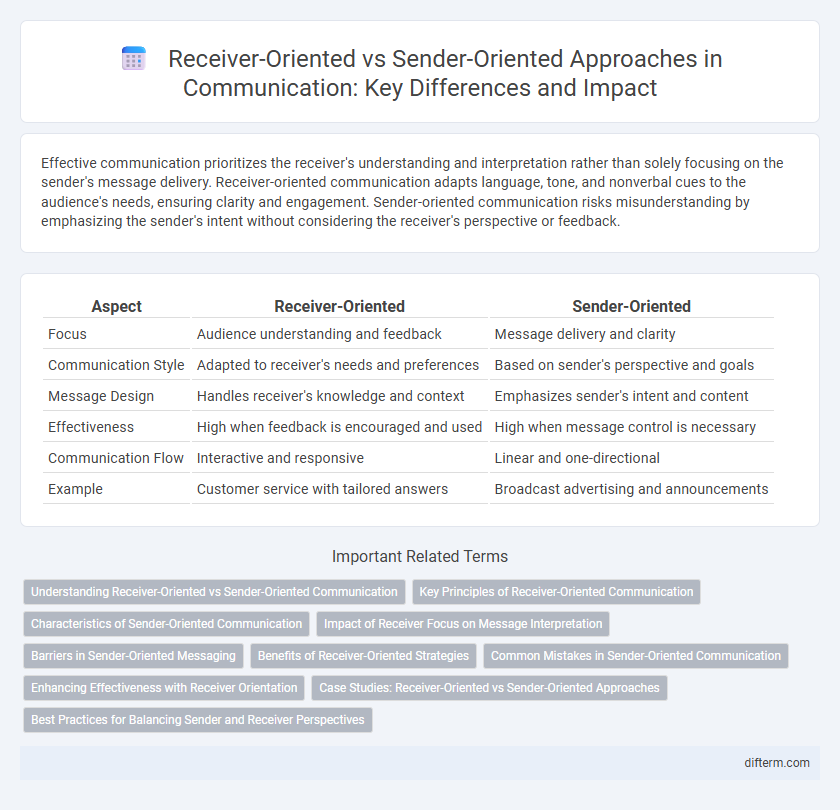Effective communication prioritizes the receiver's understanding and interpretation rather than solely focusing on the sender's message delivery. Receiver-oriented communication adapts language, tone, and nonverbal cues to the audience's needs, ensuring clarity and engagement. Sender-oriented communication risks misunderstanding by emphasizing the sender's intent without considering the receiver's perspective or feedback.
Table of Comparison
| Aspect | Receiver-Oriented | Sender-Oriented |
|---|---|---|
| Focus | Audience understanding and feedback | Message delivery and clarity |
| Communication Style | Adapted to receiver's needs and preferences | Based on sender's perspective and goals |
| Message Design | Handles receiver's knowledge and context | Emphasizes sender's intent and content |
| Effectiveness | High when feedback is encouraged and used | High when message control is necessary |
| Communication Flow | Interactive and responsive | Linear and one-directional |
| Example | Customer service with tailored answers | Broadcast advertising and announcements |
Understanding Receiver-Oriented vs Sender-Oriented Communication
Receiver-oriented communication prioritizes the needs, perspectives, and feedback of the audience to enhance message clarity and effectiveness. Sender-oriented communication focuses primarily on the transmitter's intent and content, often disregarding the receiver's interpretation or response. Understanding the contrast facilitates improved interactions by aligning message delivery with audience expectations and comprehension levels.
Key Principles of Receiver-Oriented Communication
Receiver-oriented communication prioritizes the needs, perceptions, and context of the receiver to enhance message clarity and effectiveness. It emphasizes active listening, empathy, and feedback to ensure the receiver accurately interprets the intended message. This approach reduces misunderstandings and fosters meaningful engagement by aligning communication strategies with the receiver's preferences and cognitive framework.
Characteristics of Sender-Oriented Communication
Sender-oriented communication prioritizes the transmitter's message, emphasizing clarity, completeness, and persuasion to convey ideas effectively. It often relies on structured, one-way delivery methods such as speeches, announcements, or formal reports to assert control over the information flow. This approach may overlook the receiver's feedback or interpretation, focusing primarily on transmitting a predetermined message.
Impact of Receiver Focus on Message Interpretation
Receiver-oriented communication significantly enhances message interpretation by aligning the content with the recipient's cultural background, knowledge, and expectations, which reduces misunderstandings and improves clarity. Emphasizing the receiver's perspective allows for adaptive feedback mechanisms, fostering clearer exchanges and more effective information processing. This focus increases engagement and retention, as messages become more relevant and easily understood by the audience.
Barriers in Sender-Oriented Messaging
Sender-oriented messaging faces significant barriers such as message distortion, where the sender's intent is misinterpreted by the receiver, resulting in communication breakdown. Overemphasis on the sender's perspective often ignores receiver feedback and contextual cues, leading to misunderstandings and reduced message effectiveness. These barriers highlight the critical need for adapting communication strategies to prioritize receiver orientation for clearer, more effective interactions.
Benefits of Receiver-Oriented Strategies
Receiver-oriented communication strategies enhance message clarity by prioritizing the recipient's perspective, leading to increased engagement and comprehension. These approaches facilitate active listening and tailored feedback, which help reduce misunderstandings and improve interpersonal relationships. Emphasizing receiver needs supports more effective information exchange and drives greater collaboration across diverse audiences.
Common Mistakes in Sender-Oriented Communication
Sender-oriented communication often leads to common mistakes such as overloading messages with excessive information, ignoring the receiver's perspective, and using jargon that confuses the audience. These errors result in reduced message clarity and decreased engagement from listeners or readers. Effective communication requires adapting messages to the receiver's needs and context for better understanding and response.
Enhancing Effectiveness with Receiver Orientation
Receiver-oriented communication enhances effectiveness by prioritizing the receiver's needs, preferences, and context, leading to improved message comprehension and engagement. Tailoring language, tone, and delivery methods based on receiver analysis minimizes misunderstandings and fosters meaningful interactions. This approach supports feedback integration, enabling dynamic adjustments that optimize communication outcomes.
Case Studies: Receiver-Oriented vs Sender-Oriented Approaches
Case studies highlight that receiver-oriented communication enhances message comprehension by prioritizing the audience's needs, preferences, and feedback, leading to higher engagement and retention rates. Sender-oriented approaches often emphasize message clarity and control, but may overlook audience interpretation, resulting in miscommunication or reduced effectiveness. Empirical evidence from diverse industries underscores that adapting communication strategies to receiver characteristics significantly improves overall interaction outcomes.
Best Practices for Balancing Sender and Receiver Perspectives
Effective communication requires balancing sender-oriented clarity with receiver-oriented empathy to ensure messages are both understood and well-received. Best practices include tailoring language to the receiver's knowledge level, actively seeking feedback for confirmation, and minimizing assumptions about shared context. Emphasizing mutual understanding enhances engagement and reduces miscommunication in diverse communication settings.
receiver-oriented vs sender-oriented Infographic

 difterm.com
difterm.com